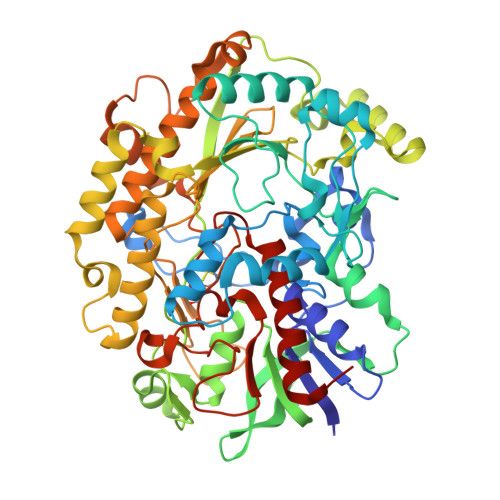Crystallographic fragment screening-based study of a novel FAD-dependent oxidoreductase from Chaetomium thermophilum.
Svecova, L., Ostergaard, L.H., Skalova, T., Schnorr, K.M., Koval', T., Kolenko, P., Stransky, J., Sedlak, D., Duskova, J., Trundova, M., Hasek, J., Dohnalek, J.(2021) Acta Crystallogr D Struct Biol 77: 755-775
- PubMed: 34076590
- DOI: https://doi.org/10.1107/S2059798321003533
- Primary Citation of Related Structures:
6ZE2, 6ZE3, 6ZE4, 6ZE5, 6ZE6, 6ZE7, 7AA2 - PubMed Abstract:
The FAD-dependent oxidoreductase from Chaetomium thermophilum (CtFDO) is a novel thermostable glycoprotein from the glucose-methanol-choline (GMC) oxidoreductase superfamily. However, CtFDO shows no activity toward the typical substrates of the family and high-throughput screening with around 1000 compounds did not yield any strongly reacting substrate. Therefore, protein crystallography, including crystallographic fragment screening, with 42 fragments and 37 other compounds was used to describe the ligand-binding sites of CtFDO and to characterize the nature of its substrate. The structure of CtFDO reveals an unusually wide-open solvent-accessible active-site pocket with a unique His-Ser amino-acid pair putatively involved in enzyme catalysis. A series of six crystal structures of CtFDO complexes revealed five different subsites for the binding of aryl moieties inside the active-site pocket and conformational flexibility of the interacting amino acids when adapting to a particular ligand. The protein is capable of binding complex polyaromatic substrates of molecular weight greater than 500?Da.
Organizational Affiliation:
Institute of Biotechnology of the Czech Academy of Sciences, v.v.i., Pr?myslov¨¢ 595, 252 50 Vestec, Czech Republic.






















